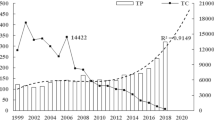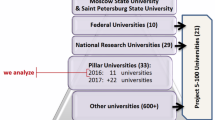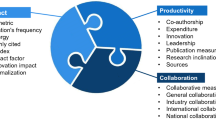Abstract
Many universities around the World have made important contributions in the field of operations research and management science. This article presents the most productive and influential universities between 1991 and 2015. For doing so, we use the Web of Science database in order to search for the information which is usually regarded as the most relevant for scientific research. The results show the country of origin of the leading universities being mainly from North America and Asia and especially from USA and China. The Centre National de la Recherche Scientifique (CNRS) of France is the most productive university while the Massachusetts Institute of Technology (MIT) of USA is the most influential one. The temporal evolution shows that USA is trailing its dominancy while China progressing quickly. The evaluation also reveals that Asian universities outperform North American universities during the last 5 years.




Similar content being viewed by others
References
Altay, N., & Green, W. G. (2006). OR/MS research in disaster operations management. European Journal of Operational Research, 175(1), 475–493.
Avkiran, N. K., & Alpert, K. (2015). The influence of co-authorship on article impact in OR/MS/OM and the exchange of knowledge with finance in the twenty-first century. Annals of Operations Research, 235(1), 51–73.
Bonilla, C. A., Merigó, J. M., & Torres-Abad, C. (2015). Economics in Latin America: A bibliometric analysis. Scientometrics, 105(2), 1239–1252.
Bornmann, L., & Daniel, H. D. (2005). Does the H-index for ranking of scientists really work? Scientometrics, 65(3), 391–392.
Brans, J. P., & Gallo, G. (2007). Ethics in OR/MS: past, present and future. Annals of Operations Research, 153(1), 165–178.
Broadus, R. N. (1987). Toward a definition of “Bibliometrics”. Scientometrics, 12, 373–379.
Cancino, C., Merigó, J. M., Coronado, F., Dessouky, Y., & Dessouky, M. (2017). Forty years of computers and industrial engineering: A bibliometric analysis. Computers & Industrial Engineering, 113, 614–629.
Corbett, C. J., & Van Wassenhove, L. N. (1993). The natural drift: What happened to operations research? Operations Research, 41(4), 625–640.
Daraio, C., Bonaccorsi, A., & Simar, L. (2015). Rankings and university performance: A conditional multidimensional approach. European Journal of Operational Research, 244, 918–930.
Evans, J. R. (1997). Creativity in OR/MS: The creative problem-solving process, Part 1. Interfaces, 27(5), 78–83.
Fahimnia, B., Sarkis, J., & Davarzani, H. (2015). Green supply chain management: A review and bibliometric analysis. International Journal of Production Economics, 162, 101–114.
Galindo, G., & Batta, R. (2013). Review of recent developments in OR/MS research in disaster operations management. European Journal of Operational Research, 230(2), 201–211.
González-Benito, J., Lannelongue, G., & Alfaro-Tanco, J. A. (2013). Study of supply-chain management in the automotive industry: A bibliometric analysis. International Journal of Production Research, 51(13), 3849–3863.
Hicks, D., Wouters, P., Waltman, L., De Rijcke, S., & Rafols, I. (2015). The Leiden manifesto for research metrics. Nature, 520(7548), 429.
Hirsch, J. E. (2005). An index to quantify an individual’s scientific research output. Proceedings of the National Academy of Sciences of the United States of America, 102, 16569–16572.
Laengle, S., Merigó, J. M., Miranda, J., Slowinski, R., Bomze, I., Borgonovo, E., et al. (2017). Forty years of the European Journal of Operational Research: A bibliometric overview. European Journal of Operational Research, 262, 803–816.
Lampe, H. W., & Hilgers, D. (2015). Trajectories of efficiency measurement: A bibliometric analysis of DEA and SFA. European Journal of Operational Research, 240, 1–21.
Landström, H., Harirchi, G., & Aström, F. (2012). Entrepreneurship: Exploring the knowledge base. Research Policy, 41(7), 1154–1181.
Leone, R. P., Robinson, L. M., Bragge, J., & Somervuori, O. (2012). A citation and profiling analysis of pricing research from 1980 to 2010. Journal of Business Research, 65(7), 1010–1024.
Lim, M. K., Bahr, W., & Leung, S. C. (2013). RFID in the warehouse: A literature analysis (1995–2010) of its applications, benefits, challenges and future trends. International Journal of Production Economics, 145(1), 409–430.
Liu, J. S., Lu, L. Y. Y., Lu, W. M., & Lin, B. J. Y. (2013). Data envelopment analysis 1978–2010: A citation-based literature survey. Omega—International Journal of Management Science, 41, 3–15.
Martínez-López, F. J., Merigó, J. M., Valenzuela, L., & Nicolás, C. (2018). Fifty years of the European Journal of Marketing: A bibliometric analysis. European Journal of Marketing, 52, 439–468.
Merigó, J. M., Cancino, C., Coronado, F., & Urbano, D. (2016). Academic research in innovation: A country analysis. Scientometrics, 108(2), 559–593.
Merigó, J. M., Gil-Lafuente, A. M., & Yager, R. R. (2015a). An overview of fuzzy research with bibliometric indicators. Applied Soft Computing, 27, 420–433.
Merigó, J. M., Mas-Tur, A., Roig-Tierno, N., & Ribeiro-Soriano, D. (2015b). A bibliometric overview of the Journal of Business Research between 1973 and 2014. Journal of Business Research, 68(12), 2645–2653.
Merigó, J. M., Pedrycz, W., Weber, R., & de la Sotta, C. (2018). Fifty years of Information Sciences: A bibliometric overview. Information Sciences, 432, 245–268.
Merigó, J. M., & Yang, J. B. (2017). A bibliometric analysis of operations research and management science. Omega—International Journal of Management Science, 73, 37–48.
Mingers, J. (2009). Measuring the research contribution of management academics using the Hirsch-index. Journal of the Operational Research Society, 60, 1143–1153.
Mingers, J., & Leydesdorff, L. (2015). A review of theory and practice in scientometrics. European Journal of Operational Research, 246, 1–19.
Mingers, J., & Xu, F. (2011). The drivers of citations in management science journals. European Journal of Operational Research, 205, 422–430.
Mishra, D., Gunasekaran, A., Papadopoulos, T., & Childe, S. J. (2016). Big Data and supply chain management: A review and bibliometric analysis. Annals of Operations Research. https://doi.org/10.1007/s10479-016-2236-y
Narin, F. (1976). Evaluative bibliometrics: The use of publication and citation analysis in the evaluation of scientific activity. Washington D.C: National Science Foundation.
Ormerod, R., & Kiossis, I. (1997). OR/MS publications: Extension of the analysis of U.S. flagship journals to the United Kingdom. Operations Research, 45(2), 178–187.
Pidd, M. (2004). Contemporary OR/MS in strategy development and policy-making: Some reflections. Journal of the Operational Research Society, 55(8), 791–800.
Podsakoff, P. M., MacKenzie, S. B., Podsakoff, N. P., & Bachrach, D. G. (2008). Scholarly influence in the field of management: A bibliometric analysis of the determinants of university and author impact in the management literature in the past quarter century. Journal of Management, 34, 641–720.
Pritchard, A. (1969). Statistical bibliography or bibliometrics? Journal of Documentation, 25, 348–349.
Reisman, A., & Kirschnick, F. (1994). The devolution of OR/MS: Implications from a statistical content analysis of papers in flagship journals. Operations Research, 42(4), 577–588.
Rinia, E. J., van Leeuwen, Th N, van Vuren, H. G., & van Raan, A. F. J. (1998). Comparative analysis of a set of bibliometric indicators and central peer review criteria. Evaluation of condensed matter physics in the Netherlands. Research Policy, 27, 95–107.
Snyder, L. V., Atan, Z., Peng, P., Rong, Y., Schmitt, A. J., & Sinsoysal, B. (2016). OR/MS models for supply chain disruptions: A review. IIE Transactions, 48(2), 89–109.
Tsoukas, H., & Papoulias, D. B. (1996). Creativity in OR/MS: From technique to epistemology. Interfaces, 26(2), 73–79.
Tur-Porcar, A., Mas-Tur, A., Merigó, J. M., Roig-Tierno, N., & Watt, J. (2018). A bibliometric history of the Journal of Psychology between 1936 and 2015. Journal of Psychology, 152, 199–225.
Valenzuela, L., Merigó, J. M., Johnston, W., Nicolás, C., & Jaramillo, F. (2017). Thirty years of the Journal of Business and Industrial Marketing: A bibliometric analysis. Journal of Business and Industrial Marketing, 32, 1–18.
Van Eck, N. J., & Waltman, L. (2010). Software survey: VOSviewer, a computer program for bibliometric mapping. Scientometrics, 84, 523–538.
Van Raan, A. F. J. (1996). Advanced bibliometric methods as quantitative core of peer review based evaluation and foresight exercises. Scientometrics, 36, 397–420.
Van Raan, A. F. J. (2004). Measuring science. Capita selecta of current main issues. In H. F. Moed, W. Glänzel, & U. Schmoch (Eds.), Handbook of quantitative science and technology research (pp. 19–50). Dordrecht: Kluwer Publishers.
Van Raan, A. F. (2006). Comparison of the Hirsch-index with standard bibliometric indicators and with peer judgment for 147 chemistry research groups. Scientometrics, 67(3), 491–502.
Wagstaff, A., & Culyer, A. J. (2012). Four decades of health economics through a bibliometric lens. Journal of Health Economics, 31(2), 406–439.
Waltman, L., & Van Eck, N. J. (2012). The inconsistency of the h-index. Journal of the Association for Information Science and Technology, 63(2), 406–415.
Wang, W., Laengle, S., Merigó, J. M., Yu, D., Herrera-Viedma, E., Cobo, M. J., et al. (2018). A bibliometric analysis of the first twenty-five years of the International Journal of Uncertainty, Fuzziness and Knowledge-Based Systems. International Journal of Uncertainty, Fuzziness and Knowledge-Based Systems, 26, 169–193.
Wysocki, R. K. (1979). OR/MS implementation research: a bibliography. Interfaces, 9(2-part-1), 37–41.
Zhang, W., & Wilhelm, W. E. (2011). OR/MS decision support models for the specialty crops industry: A literature review. Annals of Operations Research, 190(1), 131–148.
Acknowledgements
We would like to thank the editors and the anonymous reviewers for their valuable comments that have improved the quality of the paper. The corresponding author, Dr. N.M. Modak, is always grateful to Shri Bibhas Candra Das for giving endless encouragement and guidance.
Author information
Authors and Affiliations
Corresponding author
Appendix
Appendix
See Tables 16, 17, 18, 19, 20, 21 and 22.
Rights and permissions
About this article
Cite this article
Laengle, S., Merigó, J.M., Modak, N.M. et al. Bibliometrics in operations research and management science: a university analysis. Ann Oper Res 294, 769–813 (2020). https://doi.org/10.1007/s10479-018-3017-6
Published:
Issue Date:
DOI: https://doi.org/10.1007/s10479-018-3017-6




